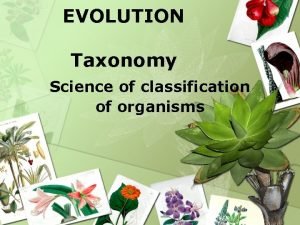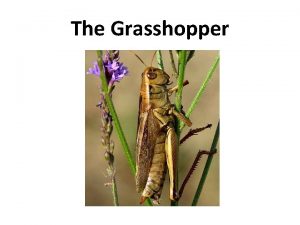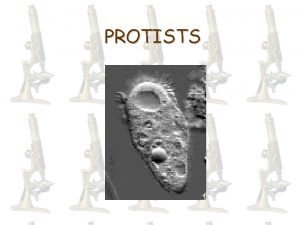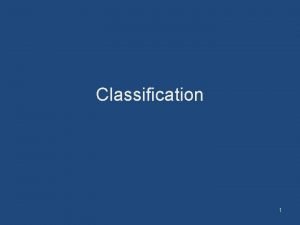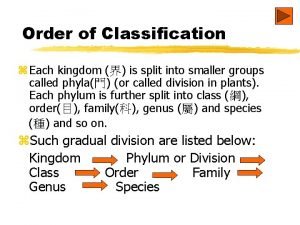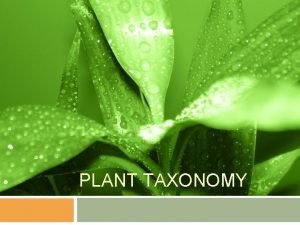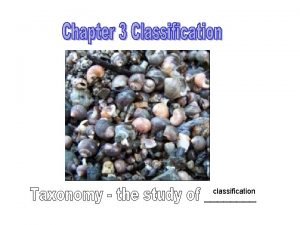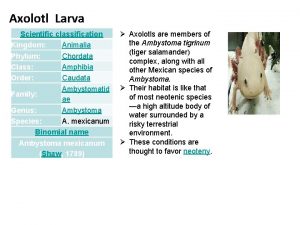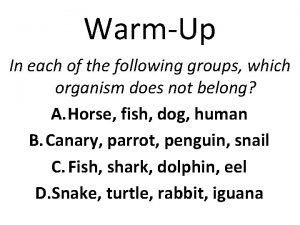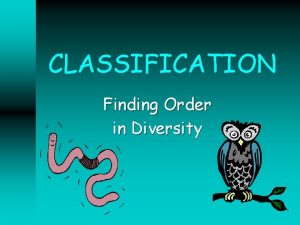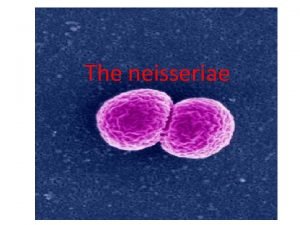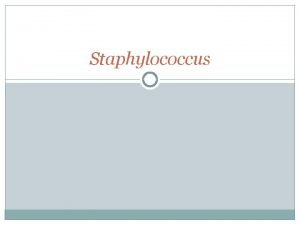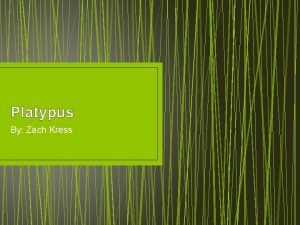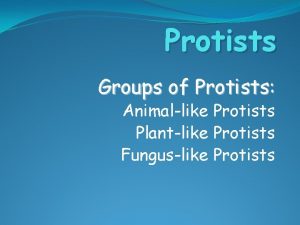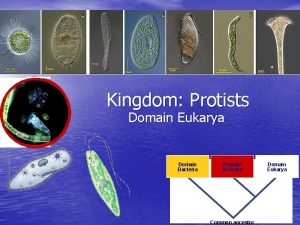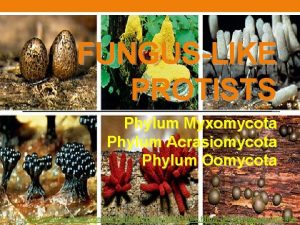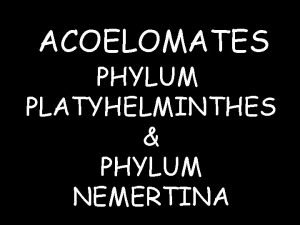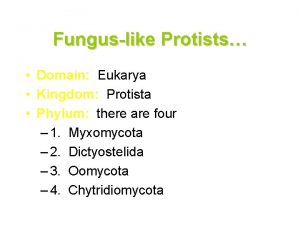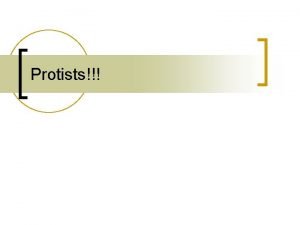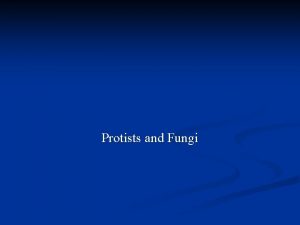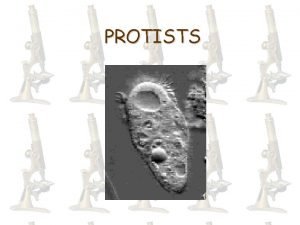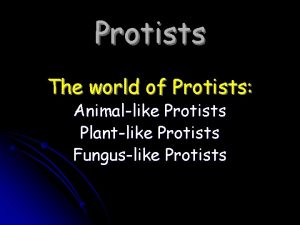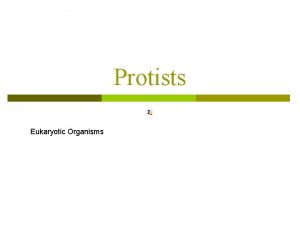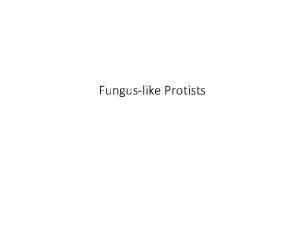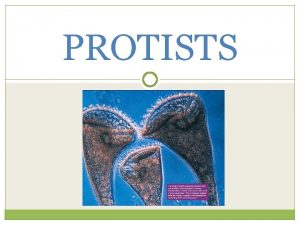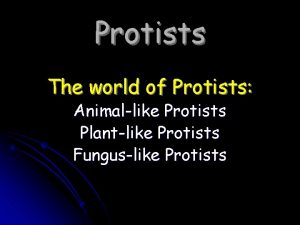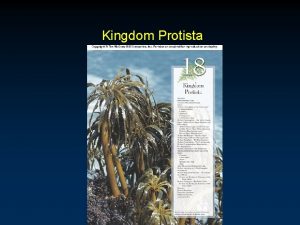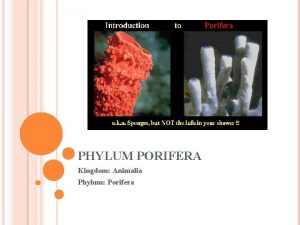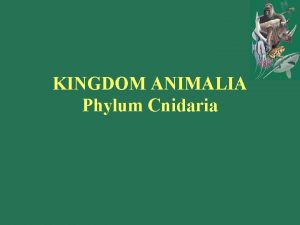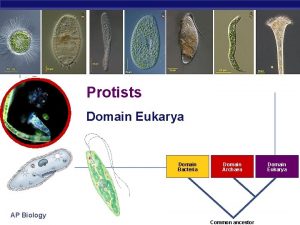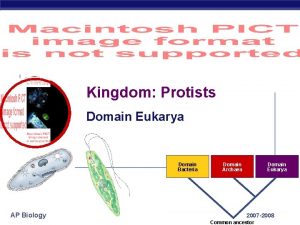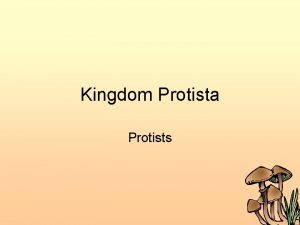PROTISTS Domains Classification Review Domain Kingdom Phylum Class

























- Slides: 25

PROTISTS

Domains

Classification Review • • Domain Kingdom Phylum Class Order Family Genus Species

Protists • Protists: • Unicellular eukaryotic organisms – very diverse • Over 115, 000 species • Eukaryotic cells - contain membrane-bound organelles (particularly mitichondria & chloroplasts) • Three major classes of protists (old system but still used) – – – Animal-like protists Plant-like protists Fungus-like protists

First Eukaryotes • 1. 5 billion years ago

Animal-like Protists • Ciliates (Cilia bearing protists) – Have cilia (short hairlike structures) on their plasma membranes

Paramecium • Important features: • Have 2 nuclei • Macronucleus • Micronucleus • Feed by forcing H 2 O into Gullet forming food vacuoles • Excrete wastes through anal pore • Excrete excess water through use of contractile vacuoles

More ciliates

Phylum Sporozoa • Usually parasitic in nature • Example is Plasmodia which causes malaria. – One of the most deadly diseases to man – Malaria is transmitted by the Anopheles mosquito.

Lifecycle of Plasmodia

Phylum Sarcodina Protists with false feet • Use extensions of cytoplasm to move and feed. • Extensions are called pseudopods (false feet)

Amoebas

More amoebas

Plant-like Protists • Are usually photosynthetic, and also heterotrophic. • Most are unicellular, most are motile

• Example is euglena. • Has a flagellum, is motile • Is both heterotrophic & autotrophic

Euglena

Dinoflagellates • Have 2 flagella for motility • • Often have a cellulose covering

Diatoms • Most abundant form of marine algae. • Form silicon (glass) shells to protect themselves

Red Algae (Rhodophyta) • Red Algae (Rhodophyta) • Red Tide Red algeal bloom

Brown Algae (Rhodophyta) • Brown Algae (Rhodophyta) – Most Plant-like of all algae. – Include kelps – Can grow to huge sizes (100') –. Giant Kelp Forest

Fungus like Protists: • Fungus like Protists: – Act as decomposers – Often have a slimy appearance/texture, hence their name. – 3 types: • Plasmodial slime molds • Cellular slime molds • Water molds

Plasmodial Slime Molds • Plasmodial Slime Molds – Can grow very large, however, is still a single cell (with many nuclei) – Feeding stage is called a plasmodium. – Forms fruiting bodies under stress.

More slime molds

Cellular Slime Molds: • Exists a majority of its life cycle as an amoeba • In times of stress these amoebas unite to form a Pseudoplasmodium, which crawls to another location (slug form), and forms a fruiting body

Water molds: molds • Water molds: – Completely aquatic – Often decomposers – Sometimes parasitic Water mold attacking a fish
 Pig domain kingdom phylum class
Pig domain kingdom phylum class Biology
Biology Class order family genus species
Class order family genus species Domain kingdom phylum class order family genus species
Domain kingdom phylum class order family genus species Class genus species
Class genus species Levels of classification domain
Levels of classification domain Old kingdom middle kingdom new kingdom
Old kingdom middle kingdom new kingdom Nnn ruled
Nnn ruled Youtube egypt
Youtube egypt Mentohotep
Mentohotep Grasshopper kingdom
Grasshopper kingdom Euglena kingdom
Euglena kingdom What phylum is a horse
What phylum is a horse Scientific taxonomy
Scientific taxonomy Dinoflagellates literally means _____.
Dinoflagellates literally means _____. Do you italicize scientific names
Do you italicize scientific names Classification order of plants
Classification order of plants What are the classifications of human?
What are the classifications of human? Axolotl kingdom
Axolotl kingdom Kingdom phylum class order of humans
Kingdom phylum class order of humans King phillip came over from great spain
King phillip came over from great spain Kingdom phylum class order
Kingdom phylum class order Bacteria kingdom phylum class order
Bacteria kingdom phylum class order Bacteria kingdom phylum class order
Bacteria kingdom phylum class order Snow leopard kingdom phylum class
Snow leopard kingdom phylum class Platypus phylum
Platypus phylum
